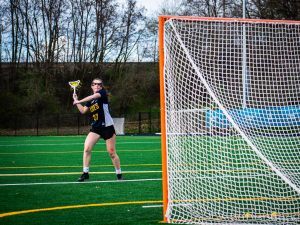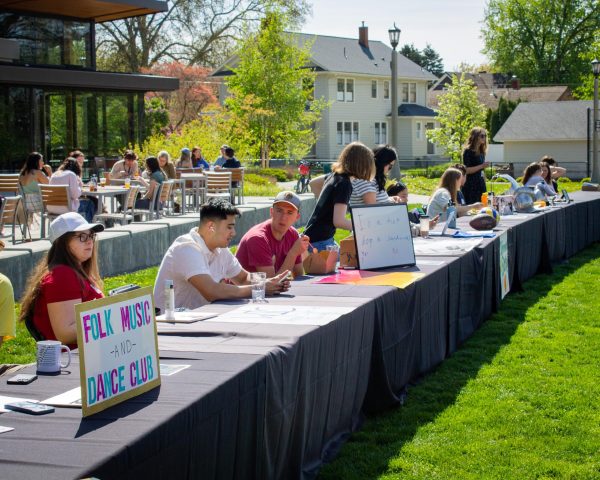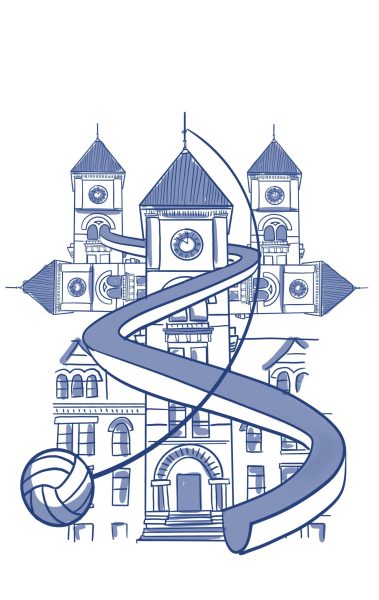A Brief History of Whitman Football
December 1, 2016
We all know the ending to this story. But few of us know the dramatic highs and definite lows encountered by Whitman College’s football team on Borleske Field over its 80 year history. It all started in 1897, when Whitman won games against Whitman Academy, Waitsburg Academy and Walla Walla High School, before losing to WAC (now Washington State University).
Over the next few years, Whitman hired its first coach, J. Arthur Baird, who was paid $600 by students for his efforts. In 1909, Whitman hosted Washington State in a game attended by 3000 spectators. However, shocked by the injuries (five men were carried off the field) and threatening nature of the fans, faculty declared that if the games were not improved, they would vote to drop football. This notion never went through.
The next decade brought forth the most notable person in the football team’s history. Raymond Borleske, a 1910 alumni of the football team, was brought back by President Penrose to coach the team, and quickly became a celebrity on campus.
After a 120-0 loss to the University of Washington (UW) in 1919, Borleske began scheduling games against smaller schools, like Pacific and Willamette, and this led to the team’s first football championship in 1921. However, the next few years saw the team only win four games in a three year span. In 1926, Borleske Field was opened, and at the stadium dedication, 5,000 watched UW beat Whitman 44-0.
Eventually, Borleske was dismissed in 1947 by President Winslow Anderson for becoming too independent and publicly criticizing Whitman’s President and trustees.
With the dismissal of Borleske, the team continued to decline. From Borleske’s dismissal in 1947, to the team’s final season in 1976, Whitman only had three winning seasons. But the school’s enthusiasm for the game shone through. In 1949, when Professor Fredric Santler, head of the athletic program’s finances, declared that weak attendance “marked the beginning of the end for Whitman in collegiate athletics,” the entire Whitman community raised enough money to wipe the deficit and start scholarships for student athletes. Whitman even progressed to winning seasons in 1958 and 1959, with a 9-7 record both years.
But Whitman’s woes were not over. In 1966, following two seasons with a combined 2-15 record, coach Keith Loper resigned, stating that Whitman needed a larger coaching staff where coaches were not also in charge of teaching classes.
In 1967, Whitman decided to devote more resources towards its football team, and new Coach Bob Thomsen was brought in. The team saw immediate improvements and hit its peak in 1969, with a 6-3 record that led to Whitman being co-champions of the Northwest Conference.
In the fall of 1971, President Richard Nixon stopped in Walla Walla in route to a visit at the Hanford Nuclear Site. After contacting the White House, co-captains of Whitman’s football team were able to present the president with a Whitman jersey at the airport. Nixon declared, “It’s the closest I ever came to making the team. It’s the greatest compliment I’ve ever received on one of these trips.”
However, this stirred great controversy in the Whitman community, as a picture of Nixon holding the jersey was published in newspapers coast to coast. Within a year, student body officers passed a resolution which asked the President to return the jersey “for not acting on his campaign promises to end American involvement in Indochina.” This request was never fulfilled.
By 1975, Whitman’s team had fallen back to old ways. The team finished 1-7, and ongoing debates to discontinue the team intensified. But the 1976 Whitman football players finished the season unaware that they had played their last game. On February 28th, 1977 President Robert Skotheim announced that the college would move to discontinue the football program, pending approval by the board of trustees. Almost immediately, near 500 students protested outside of Cordiner, citing the lack of student voices in the decision. In a quote for The Whitman Pioneer, President Skotheim declared, “This is not really news and this is really not a surprise to anyone who has watched Whitman football in the past years.”
After the trustees voted to discontinue football, alumni immediately began voicing their concerns. “I am afraid that dropping football may have a very serious effect on the future of Whitman and that the generous giving of the alumni toward its support may drop considerably,” alumnus W.E. “Bill”Berney, class of 1915, wrote in a Letter to the Editor of The Pioneer.
In the years that followed, President Skotheim’s decision has been seen with increasing favorability.
“At the time I was not supportive [of the decision] as I viewed a football team as an important part of college and the college experience. Looking back, it was a sound fiscal decision.” Member of the College Athletic Committee John Blackmon ‘79 said.
In 2008, Whitman’s Football team was able to take the field one more time. Football alumni were invited back for a special reunion. “We wanted to let players know we understood their frustrations and valued their feelings.” Nancy Mitchell, Associate Director of Alumni said.
The event was a huge hit. 94 players and five coaches made the trip across the United States to visit Borleske Stadium. “I believe it was a very good move by President [George] Bridges to begin the healing process by inviting football players back to campus to acknowledge and honor them as an important part of the college’s past,” Blackmon said.
In its 80 year history, Whitman only sported a 37 percent winning percentage, but the impact of the program spread all the way from Borleske Stadium to the Oval Office. The spirit of the program lives on in the heart of many of our alumni, and thus remains an important part of our history as an institution.








Neal Zoumboukos • Apr 29, 2017 at 8:39 am
Can you tell the win/loss record of each head football coach at Whitman College during the 60’s and 70’s until the program was dropped? Thank you for your time.